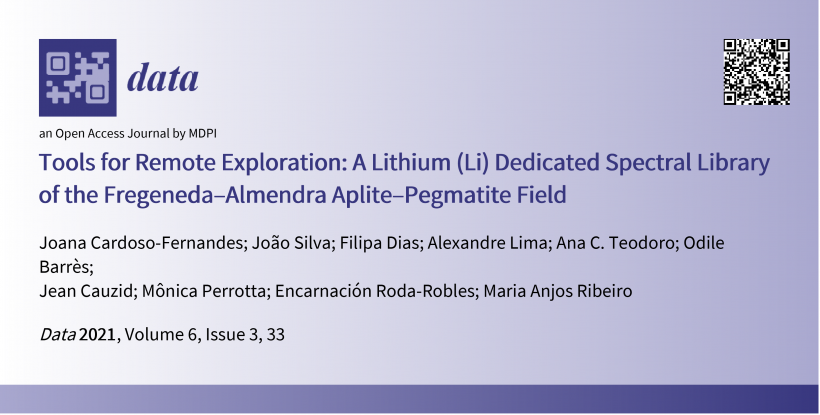Cardoso-Fernandes, J.; Silva, J.; Dias, F.; Lima, A.; Teodoro, A.C.; Barrès, O.; Cauzid, J.; Perrotta, M.; Roda-Robles, E.; Ribeiro, M.A. Tools for Remote Exploration: A Lithium (Li) Dedicated Spectral Library of the Fregeneda–Almendra Aplite–Pegmatite Field. Data 2021, 6, 33. https://doi.org/10.3390/
The existence of diagnostic features in the visible and infrared regions makes it possible to use reflectance spectra not only to identify mineral assemblages but also for calibration and classification of satellite images, considering lithological and/or mineral mapping. For this purpose, a consistent spectral library with the target spectra of minerals and rocks is needed. Currently, there is big market pressure for raw materials including lithium (Li) that has driven new satellite image applications for Li exploration. However, there are no reference spectra for petalite (a Li mineral) in large, open spectral datasets. In this work, a spectral library was built exclusively dedicated to Li minerals and Li pegmatite exploration through satellite remote sensing. The database includes field and laboratory spectra collected in the Fregeneda–Almendra region (Spain–Portugal) from (i) distinct Li minerals (spodumene, petalite, lepidolite); (ii) several Li pegmatites and other outcropping lithologies to allow satellite-based lithological mapping; (iii) areas previously misclassified as Li pegmatites using machine learning algorithms to allow comparisons between these regions and the target areas. Ancillary data include (i) sample location and coordinates, (ii) sample conditions, (iii) sample color, (iv) type of face measured, (v) equipment used, and for the laboratory spectra, (vi) sample photographs, (vii) continuum removed spectra files, and (viii) statistics on the main absorption features automatically extracted. The potential future uses of this spectral library are reinforced by its major advantages: (i) data is provided in a universal file format; (ii) it allows users to compare field and laboratory spectra; (iii) a large number of complementary data allow the comparison of shape, asymmetry, and depth of the absorption features of the distinct Li minerals. View Full-Text

